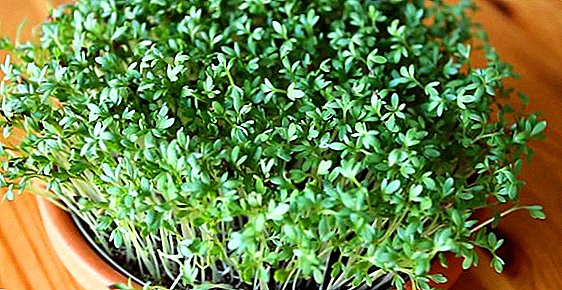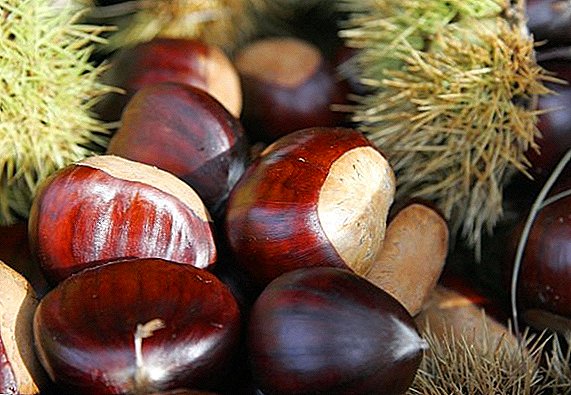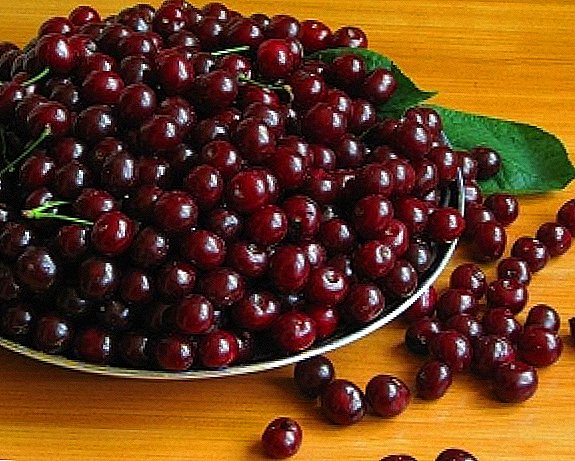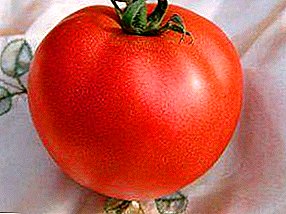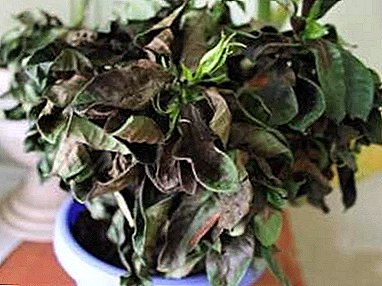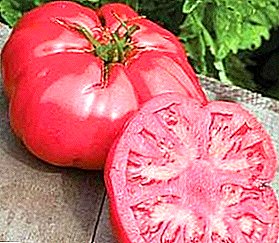
"Pink Elephant" - the original variety of tomatoes, responsive to care. Attentive gardeners who observe the rules of watering and do not skimp on top dressing can get stable yields of selected, large and very tasty tomatoes.
In this material you can find useful information not only about the description of the variety, but about the characteristics of the tomato, its tendency or resistance to diseases, peculiarities of care and cultivation.
Pink Elephant Tomatoes: variety description
| Grade name | Pink Elephant |
| general description | Mid-season determinant large-fruited variety |
| Originator | Russia |
| Ripening | 105-110 days |
| The form | Flattened-rounded with pronounced ribbing |
| Colour | Dark pink |
| Average tomato mass | 300-1000 grams |
| Application | Dining room |
| Yield varieties | 7-8 kg per square meter |
| Features of growing | Dislikes thickening landing |
| Disease resistance | Resistant, but prevention does not hurt |
"Pink Elephant" - large-fruited mid-season variety. The bush is determinant, it reaches 1.5 m in height, requires pasynkovaniya. Moderate formation of green mass, potato leaf, medium-sized, dark green. Fruits ripen in small clusters of 3-4 pieces. From 1 square. m landings you can get 7-8 kg of selected tomatoes.
You can compare the yield of a variety with other varieties in the table below:
| Grade name | Yield |
| Pink Elephant | 7-8 kg per square meter |
| Frost | 18-24 kg per square meter |
| Union 8 | 15-19 kg per square meter |
| Balcony miracle | 2 kg from a bush |
| Red dome | 17 kg per square meter |
| Blagovest F1 | 16-17 kg per square meter |
| King early | 12-15 kg per square meter |
| Nikola | 8 kg per square meter |
| Ob domes | 4-6 kg from a bush |
| King of Beauty | 5.5-7 kg from a bush |
| Pink meaty | 5-6 kg per square meter |
Fruits are large, weighing from 300 g to 1 kg. On the lower branches of the tomatoes are larger. The form is flattened-rounded, with pronounced ribbing at the stem. The skin is dense, but not rigid, reliably protecting the fruit from cracking.
You can compare the weight of the fruits of this variety with others in the table:
| Grade name | Fruit weight |
| Pink Elephant | 300-1000 grams |
| La la fa | 130-160 grams |
| Alpatieva 905A | 60 grams |
| Pink flamingo | 150-450 grams |
| Tanya | 150-170 grams |
| Apparently invisible | 280-330 grams |
| Early love | 85-95 grams |
| The baron | 150-200 grams |
| Apple Russia | 80 grams |
| Valentine | 80-90 grams |
| Katya | 120-130 grams |
Color is dark pink, monophonic, without spots. The flesh is fleshy, juicy, with a small number of seeds, sugary at the break. Delicious taste, rich and sweet, without sourness. High content of sugars and beneficial amino acids.
 Read on our site all about the diseases of tomatoes in greenhouses and how to combat these diseases.
Read on our site all about the diseases of tomatoes in greenhouses and how to combat these diseases.We also offer materials on high-yielding and disease-resistant varieties.
A photo
See below - Pink Elephant Tomato photo:



Origin and Application
Pink Elephant Tomatoes - variety, bred by Russian breeders, intended for cultivation in different regions. The tomato is thermophilic, suitable for planting in greenhouses. When planting on open beds requires film cover. Harvested tomatoes are well kept, transportation is possible.
Juicy and large fruits belong to the salad variety. They can be eaten fresh, used to prepare various dishes, from snacks to juices. Ripe tomatoes make delicious sauces, mashed potatoes and juices that you can drink fresh or canned.
Advantages and disadvantages
Among the main advantages of the variety:
- large fruits of excellent taste;
- good yield;
- resistance to major diseases.
Among the shortcomings of the variety:
- the need for careful formation of a sprawling tall bush;
- demanding on temperature, watering, quality feedings.
Features of growing
 Sowing seeds for seedlings begins in the second half of March. It is convenient to use special containers with lids, but any deep container with drainage holes and a tray fits.
Sowing seeds for seedlings begins in the second half of March. It is convenient to use special containers with lids, but any deep container with drainage holes and a tray fits.
Before sowing, seeds are soaked in a growth stimulator for 10-12 hours. It is recommended to disinfect seeds collected independently, dropping a half hour into a pink solution of potassium permanganate. It is better to use the seeds collected 2-3 years ago, they are distinguished by almost one hundred percent germination.
For the cultivation of tomatoes "Pink Elephant" soil is made up of a mixture of garden soil with humus in equal proportions. You can add a little river sand and wood ash to the substrate. The soil is compacted tightly in containers, the seeds are planted with a depth of 2 cm. Plants are sprayed with warm water, covered with foil and placed in heat.
Read also the detailed articles about the soil for adult plants in greenhouses. We will tell you about what types of soil for tomatoes exist, how to prepare the right soil on your own and how to prepare the soil in the greenhouse in spring for planting.
After the emergence of shoots the film is removed, the temperature drops to 15-16 degrees. This mode lasts 5-7 days, then the temperature rises to normal room temperature. The procedure strengthens the immune system of plants and increases the future yield. For successful development, tomatoes need a bright light and moderate watering with warm water.
After unfolding the first pair of these leaves, tomatoes swoop in separate containers. Then the tomatoes are fed diluted complex fertilizer. If the shoots look pale and stretched, it is worthwhile to add a small portion of nitrogenous fertilizers.
In the greenhouse, the pink elephant variety of tomato is transplanted in the second half of May; seedlings are moved to the open beds later, closer to June.
The soil should be completely warm. On 1 square. m can accommodate no more than 2 plants, thickening plantings greatly reduces the yield. As the plants grow, branches and fruits are tied to supports. You can use rods or stakes, but it is much more convenient to grow tall bushes on the trellis.
In order for the fruits to be large, it is recommended to remove the stepsons, forming the plant in one stem. On each brush 3-4 flowers are left, the deformed and small ones are removed. Watering moderate, warm settled water. In between, the soil is loosened for better air access to the roots. During the season, tomatoes need to be fed 3-4 times with mineral fertilizers.
Before the beginning of flowering, nitrogen-containing complexes are used, after the formation of ovaries, superphosphate or magnesium sulfate should be applied. You can feed the bushes with organic matter, but do it no more than 1 time per month.
Read more about fertilizers for tomatoes in the articles of our site.:
- Organic, mineral, phosphoric, complex and ready-made fertilizers for seedlings and TOP best.
- Yeast, iodine, ammonia, hydrogen peroxide, ash, boric acid.
- What is foliar feeding and when picking, how to conduct them.
 Learn more about the most common tomato diseases in greenhouses here. We will also tell you about ways to deal with them.
Learn more about the most common tomato diseases in greenhouses here. We will also tell you about ways to deal with them.On our site you will find reliable information about such misfortunes as Alternaria, Fusarium, Verticillis, Phytophlorosis and ways to protect against Phytophthora.
Diseases and pests
 The variety is sufficiently resistant to diseases, but without minimal preventive measures can not do. Before planting, the soil is shed with a solution of potassium permanganate or copper sulfate for disinfection. To avoid the emergence of root, gray or apical rot, weeds are removed in a timely manner, and the soil is loosened.
The variety is sufficiently resistant to diseases, but without minimal preventive measures can not do. Before planting, the soil is shed with a solution of potassium permanganate or copper sulfate for disinfection. To avoid the emergence of root, gray or apical rot, weeds are removed in a timely manner, and the soil is loosened.
Watering an Elephant Pink variety tomato is only needed with warm water, after the topsoil has dried out. Permanent waterlogging is dangerous for tomatoes. After watering, it is recommended to ventilate the greenhouse to reduce the humidity of the air.
Establishing a drip irrigation system and mulching the soil with straw, humus or peat will help to maintain the normal level of humidity and prevent stagnation of water.
When growing a pink elephant tomato during fruiting, late blight can threaten the tomatoes. Having noticed dark spots on the fruit or leaves, it is necessary to process the plantings with copper preparations abundantly. Fruit spotting may be caused by a lack of potassium in the soil. Applying a portion of fertilizer quickly solves the problem.
To get rid of insect pests by using industrial insecticides, decoctions of celandine, onion peel or chamomile. These funds are excellent for spider mites, whitefly, thrips. You can get rid of aphids by washing the affected parts of tomatoes with warm soapy water. Bare slugs are harvested by hand, the plants are sprayed with an aqueous solution of ammonia.
Large and elegant pink tomatoes enjoy the deserved love of gardeners. As you can see from the description of the tomato "Pink Elephant" - the variety is quite demanding to care, but responds willingly with care and attention, demonstrating an enviable yield. Seeds for subsequent plantings can be harvested on their own, from the most ripe tomatoes.
| Early maturing | Middle late | Medium early |
| Crimson Viscount | Yellow banana | Pink Bush F1 |
| The Tsar Bell | Titanium | Flamingo |
| Katya | F1 slot | Openwork |
| Valentine | Honey salute | Chio Chio San |
| Cranberries in sugar | Miracle of the market | Supermodel |
| Fatima | gold fish | Budenovka |
| Verlioka | De barao black | F1 major |



